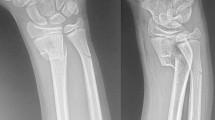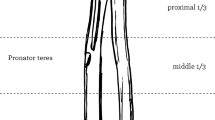Abstract
Summary
We designed a study to compare the efficacy of five main therapeutic options, including external fixation, open reduction and plate osteosynthesis (ORPO), minimally invasive plate osteosynthesis (MIPO), dynamic compression plate (DCP), and intramedullary nail (IMN) in treating humeral shaft fractures. Our results indicated that MIPO and IMN were recommended as the optimal treatments for clinical use.
Purpose
Nowadays, five main therapeutic options are used in treating humeral shaft fractures: external fixation, open reduction and plate osteosynthesis (ORPO), minimally invasive plate osteosynthesis (MIPO), dynamic compression plate (DCP), and intramedullary nail (IMN). Aiming to provide reliable evidence for clinical selection, we designed a network meta-analysis (NMA) to evaluate the efficacy of these treatments.
Methods
NMA was conducted on Bayesian framework with software R 3.3.2 and STATA 13.0. Nonunion rate, radial nerve palsy rate, union time, complication rate, and infection rate were considered as primary outcomes. Mean operation time was the secondary outcome. The outcomes were measured by odds ratio (OR) value and corresponding 95% credible intervals (CrIs) or mean difference (MD) with 95% CrIs. Surface under cumulative ranking curve (SUCRA) was calculated to show the ranking probability of each treatment.
Results
Our results indicated that ORPO had a higher risk of radial nerve palsy than MIPO (OR = 2.83, 95% CrIs = 1.28–6.23), and DCP had a better performance in preventing complications than IMN (OR = 0.31, 95% CrIs = 0.11–0.84); no other significant difference were observed. According to the SUCRA results, MIPO had a high-ranking probability in almost all outcomes, while external fixation had lowest values in the majority of outcomes.
Conclusions
We recommended MIPO as the optimal treatment for humeral shaft fractures after taking all outcomes into consideration; IMN was also recommended for its relatively good performance, but its complication still needed to be noticed.



Similar content being viewed by others
References
Carroll EA, Schweppe M, Langfitt M, Miller AN, Halvorson JJ (2012) Management of humeral shaft fractures. J Am Acad Orthop Surg 20:423–433
Ekholm R, Adami J, Tidermark J, Hansson K, Tornkvist H, Ponzer S (2006) Fractures of the shaft of the humerus. An epidemiological study of 401 fractures. J Bone Joint Surg Br Vol 88:1469–1473
Marsh JL, Slongo TF, Agel J et al (2007) Fracture and dislocation classification compendium—2007: Orthopaedic Trauma Association classification, database and outcomes committee. J Orthop Trauma 21:S1–133
Walker M, Palumbo B, Badman B, Brooks J, Van Gelderen J, Mighell M (2011) Humeral shaft fractures: a review. J Shoulder Elb Surg 20:833–844
Anglen JO, Archdeacon MT, Cannada LK, Herscovici D Jr (2008) Avoiding complications in the treatment of humeral fractures. J Bone Joint Surg Am 90:1580–1589
Sarahrudi K, Wolf H, Funovics P, Pajenda G, Hausmann JT, Vecsei V (2009) Surgical treatment of pathological fractures of the shaft of the humerus. J Trauma 66:789–794
Jiang R, Luo CF, Zeng BF, Mei GH (2007) Minimally invasive plating for complex humeral shaft fractures. Arch Orthop Trauma Surg 127:531–535
Denard A, Jr., Richards JE, Obremskey WT, Tucker MC, Floyd M, Herzog GA (2010) Outcome of nonoperative vs operative treatment of humeral shaft fractures: a retrospective study of 213 patients. Orthopedics 33. https://doi.org/10.3928/01477447-20100625-16
Davies G, Yeo G, Meta M, Miller D, Hohmann E, Tetsworth K (2016) Case-match controlled comparison of minimally invasive plate osteosynthesis and intramedullary nailing for the stabilization of humeral shaft fractures. J Orthop Trauma 30:612–617
Zhang Q, Sun N, Huang Q, Zhu S, Wu X (2017) Minimally Invasive Plating Osteosynthesis in the Treatment of Humeral Shaft Fractures: A Meta-Analysis. J Investig Surg 30:133–142
Hu X, Xu S, Lu H, Chen B, Zhou X, He X, Dai J, Zhang Z, Gong S (2016) Minimally invasive plate osteosynthesis vs conventional fixation techniques for surgically treated humeral shaft fractures: a meta-analysis. J Orthop Surg Res 11:59
Ma J, Xing D, Ma X, Gao F, Wei Q, Jia H, Feng R, Yu J, Wang J (2013) Intramedullary nail versus dynamic compression plate fixation in treating humeral shaft fractures: grading the evidence through a meta-analysis. PLoS One 8:e82075
Sutton AJ, Abrams KR (2001) Bayesian methods in meta-analysis and evidence synthesis. Stat Methods Med Res 10:277–303
Bemelman M, van Baal M, Yuan JZ, Leenen L (2016) The role of minimally invasive plate osteosynthesis in rib fixation: a review. Korean J Thorac Cardiovasc Surg 49:1–8
Perren SM (2002) Evolution of the internal fixation of long bone fractures. The scientific basis of biological internal fixation: choosing a new balance between stability and biology. J Bone Joint Surg Br Vol 84:1093–1110
Zhiquan A, Bingfang Z, Yeming W, Chi Z, Peiyan H (2007) Minimally invasive plating osteosynthesis (MIPO) of middle and distal third humeral shaft fractures. J Orthop Trauma 21:628–633
Yu BF, Liu LL, Yang GJ, Zhang L, Lin XP (2016) Comparison of minimally invasive plate osteosynthesis and conventional plate osteosynthesis for humeral shaft fracture: a meta-analysis. Medicine 95:e4955
Qiu H, Wei Z, Liu Y, Dong J, Zhou X, Yin L, Zhang M, Lu M (2016) A Bayesian network meta-analysis of three different surgical procedures for the treatment of humeral shaft fractures. Medicine 95:e5464
Kurup H, Hossain M, Andrew JG (2011) Dynamic compression plating versus locked intramedullary nailing for humeral shaft fractures in adults. Cochrane Database Syst Rev CD005959. https://doi.org/10.1002/14651858.CD005959.pub2
Dai J, Chai Y, Wang C, Wen G (2014) Dynamic compression plating versus locked intramedullary nailing for humeral shaft fractures: a meta-analysis of RCTs and nonrandomized studies. J Orthop Sci: Off J Jpn Orthop Assoc 19:282–291
Acknowledgements
We would like to acknowledge the reviewers for their helpful comments on this paper. This research did not receive any specific grant from funding agencies in the public, commercial, or not-for-profit sectors.
Author information
Authors and Affiliations
Corresponding author
Ethics declarations
Conflict of interest
None.
Electronic supplementary material
Fig. S1
Net heat plot. The size of the gray squares indicates the contribution of the direct evidence (shown in the column) to the network evidence (shown in the row). The colors are associated with the change in inconsistency between direct and indirect evidence (shown in the row) after detaching the effect of each component meta-analysis (shown in the column). Blue colors indicate an increase of inconsistency and warm colors indicate a decrease (the stronger the intensity of the color, the stronger the change) (JPEG 1325 kb)
Fig. S2
Publication bias (JPEG 1603 kb)
Table S1
(DOCX 19 kb)
Table S2
(DOCX 21 kb)
Table S3
(DOCX 16 kb)
Rights and permissions
About this article
Cite this article
Zhao, Y., Wang, J., Yao, W. et al. Interventions for humeral shaft fractures: mixed treatment comparisons of clinical trials. Osteoporos Int 28, 3229–3237 (2017). https://doi.org/10.1007/s00198-017-4174-1
Received:
Accepted:
Published:
Issue Date:
DOI: https://doi.org/10.1007/s00198-017-4174-1




